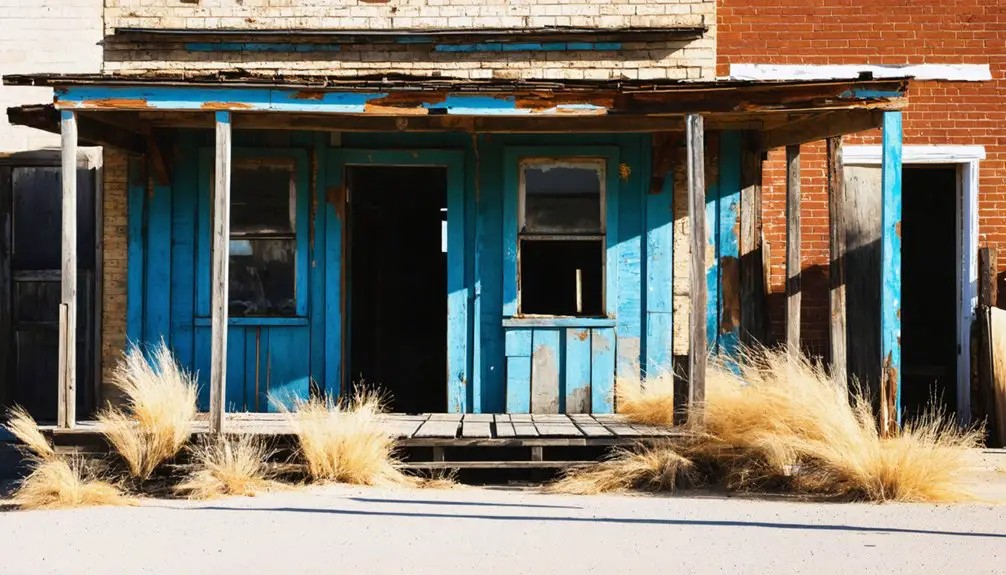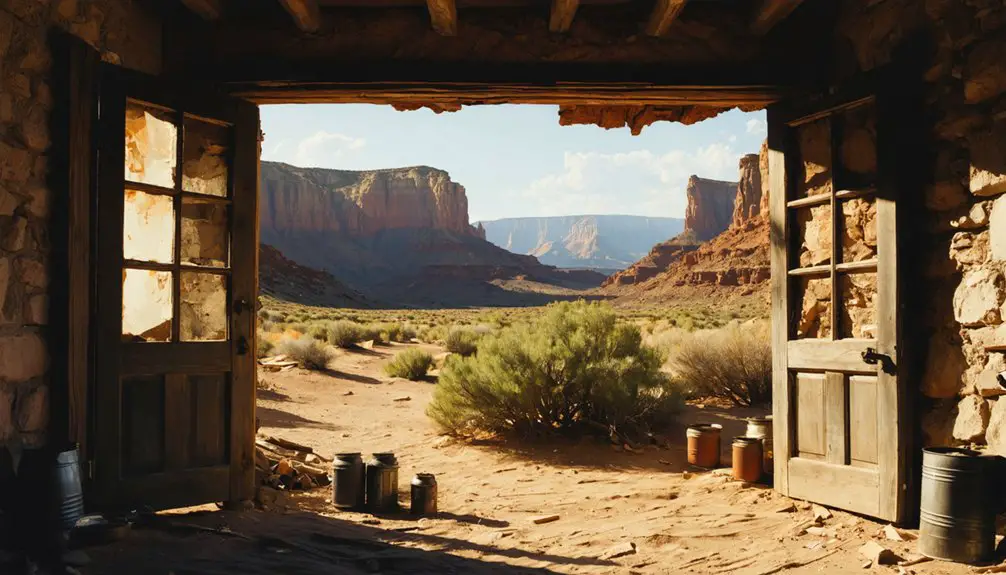You’ll discover Blue Creek’s remnants near the historic Union Pacific Railroad line, where it began as a construction camp called “Dead Fall” in the late 1860s. The site housed 300 freed slaves and Mormon laborers who built the transcontinental railroad before evolving into an agricultural settlement. Though abandoned after 1934 when its school closed, you can still find the weathered two-room schoolhouse and boarding house that tell tales of pioneering spirit and determination.
Key Takeaways
- Blue Creek began as a Union Pacific Railroad construction camp in the 1860s, initially known as “Dead Fall” or “Hell’s Half Acre.”
- The settlement transformed from a railroad camp into an agricultural community, with pioneering families establishing farms in the early 1900s.
- The community featured a school (established 1914), Lewis Grant’s store (1910), and boarding houses serving both railroad workers and farming families.
- Blue Creek’s decline began with economic changes and harsh farming conditions, marked significantly by the school’s closure in 1934.
- Today, remnants include an old two-room schoolhouse and boarding house, preserving the ghost town’s legacy of railroad and agricultural history.
The Railroad Camp Origins
When the Union Pacific Railroad pushed westward during the late 1860s, Blue Creek emerged as an essential construction camp on the eastern slope of Utah’s North Promontory Mountains.
You’d have found a bustling tent town where crews worked tirelessly to grade and prepare the railroad bed for the transcontinental railroad‘s completion. Known as “Dead Fall” or “Hell’s Half Acre,” this rough settlement reflected the labor struggles of its diverse workforce, including 300 freed slaves and Mormon laborers under Brigham Young’s direction.
Hell’s Half Acre bustled with freed slaves and Mormon workers, toiling under harsh conditions to build America’s great transcontinental dream.
The camp’s strategic location near Blue Creek Spring made it significant during the race between Union Pacific and Central Pacific companies. The settlement was named after Blue Creek Spring, located just 2.5 miles to the south.
Workers faced brutal conditions while building the rail line, establishing a temporary community complete with saloons, restaurants, and stores to support their demanding work. Teams of workers used wheelbarrows and shovels to shape the challenging terrain into suitable railroad grade.
Pioneer Settlement and Early Community Life
After the railroad’s completion, Blue Creek transformed from a rough-and-tumble construction camp into an agricultural settlement, where pioneering families carved out homesteads from the sage-covered landscape.
Early settlers like Kumen Tarbet, George Henrie, and Fred Manning exemplified pioneer cooperation as they tackled the backbreaking work of clearing sagebrush using oxen, later switching to mules and horses. The settlers established their first school in 1914. Commercial life grew as Lewis Grant’s store opened in 1910 to serve local families and travelers.
You’ll find their legacy in the community identity that formed around shared challenges, particularly the essential task of accessing water. Settlers hand-dug wells up to 400 feet deep, including a crucial community well near the “Big Field.”
The Peter Jensens family’s well, fitted with pipe ladders for maintenance, demonstrated the ingenuity required for survival. Daily life centered on manual labor, with scattered homesteads and a small post office serving as anchors for this determined farming community.
Agricultural Development and Land Transformation
You’ll find that Blue Creek’s earliest farmers faced immense physical challenges as they cleared the native sagebrush and bunchgrass using manual methods with oxen, mules, and horses.
The arduous process of railing, stacking, burning, and plowing transformed wild grazing lands into cultivated fields suitable for farming. The rich soil from ancient Lake Bonneville provided an excellent foundation for agricultural development.
Your understanding of early agriculture wouldn’t be complete without recognizing how these settlers had to carefully select crops that could survive in the semi-arid climate while dealing with the limitations of hand tools and animal power. The establishment of Utah State University research facilities in 1966 marked a significant shift toward modern agricultural practices in the region.
Land Clearing Methods
During the early settlement of Blue Creek, land clearing emerged as a critical first step in transforming the native sagebrush terrain into productive farmland.
You’d find early settlers like Kumen Tarbet employing manual techniques with oxen, later switching to mules and horses. They’d use a method called railing to remove sagebrush and bunchgrass, stacking the cleared vegetation for controlled burns.
As you entered the early 20th century, mechanized advancements revolutionized the process. This transformation eventually led to the establishment of what would become a 12,000 acre farm dedicated to wheat production.
Tractors replaced animal power, enabling faster soil preparation and the cultivation of previously challenging areas. These innovations drastically reduced the physical demands of land transformation.
The shift from manual to mechanical methods allowed farmers to clear larger tracts of land more efficiently, supporting Blue Creek’s agricultural expansion and the region’s economic growth.
Crop Adaptation Challenges
While transforming Blue Creek’s native landscape into productive farmland presented significant challenges, the adaptation of suitable crops proved equally demanding. You’d need crop resilience to overcome multiple environmental hurdles – from drought conditions and pest threats to alkaline soils and short growing seasons.
The region’s irrigation challenges made water scarcity a constant concern, forcing farmers to select drought-tolerant varieties and implement efficient water management strategies.
The harsh northern Utah climate, with its cold winters and unpredictable frost patterns, required carefully timed planting schedules.
Utah State University’s research focused on developing resilient crop varieties through extensive trials. These studies helped determine which crops could withstand local conditions while remaining economically viable.
Success depended on crops adapting to both environmental pressures and limited water resources.
Daily Life in Blue Creek’s Peak Years
You’d find two distinct social spheres in Blue Creek during its heyday: the lively railroad workers gathering at Lewis Grant’s dance hall and boarding house, and the hardworking farm families tending their cleared lands.
The railroad workers’ evenings often centered around the two-story Grant building, where they’d find lodging, entertainment, and a chance to socialize after long days laying track. The workers were vital to the Transcontinental Railroad construction that helped establish communities across Utah.
Farm families structured their days around intensive manual labor – clearing sagebrush, plowing fields, and maintaining their homesteads while relying on the general stores and blacksmith services for essential supplies and repairs.
Railroad Workers’ Social Scene
The clanging of railroad spikes and raucous laughter from saloon tents defined daily life in Blue Creek’s bustling worker camps of 1869.
You’d find a rich tapestry of cultural diversity among the workers – Irish immigrants sharing stories with freed slaves, Chinese laborers gathering in their own circles, and Mormon crews maintaining community bonds. Workers sent money to their families back home while enduring the harsh frontier conditions. Chinese workers faced especially difficult circumstances, earning $10-15 less than their white counterparts.
This social camaraderie helped workers cope with grueling conditions and isolation.
- Nicknamed “Dead Fall” and “Hell’s Half Acre” for its rough-and-tumble atmosphere
- Saloons served as community hubs for gambling, drinking, and storytelling
- Workers formed tight-knit groups along ethnic and cultural lines
- Music and card games offered escape from backbreaking labor
- Pop-up businesses like restaurants and dry goods stores served daily needs
Farm Family Daily Routines
Far from the raucous railroad camps, Blue Creek’s farm families followed dawn-to-dusk routines shaped by the harsh demands of frontier agriculture.
You’d find everyone pitching in – women and children handling family chores like food preparation and preservation while men worked the fields with horse-drawn plows.
Livestock care dominated daily schedules, as your animals needed constant feeding and watering at community wells.
You’d spend hours maintaining equipment, fighting wheat diseases, and hauling water when individual sources ran dry.
Each season brought its own intensive labor – spring planting, summer cultivation, and fall harvest.
After dark, you’d gather by lamplight to prepare for the next day’s work.
Neighboring families shared resources and labor, creating tight-knit support networks essential for survival in Blue Creek’s unforgiving environment.
The Path to Abandonment

Although Blue Creek began with promise as a Union Pacific construction camp in the late 1860s, its journey toward abandonment emerged through a complex interplay of environmental and economic challenges.
You’ll find the town’s population decline accelerated as economic shifts diminished opportunities, with harsh winters and short growing seasons making farming unsustainable.
- Murder of a crucial storekeeper disrupted community stability
- School closure in 1934 signaled dwindling population
- Short growing seasons limited crop yields and profitability
- Mechanization of agriculture reduced need for small farming communities
- Changes in transportation networks isolated the settlement
Historical Legacy and Modern Remnants
Standing as a tribute to frontier ambition, Blue Creek’s historical legacy lives on through its remaining physical structures and documented stories of pioneer determination.
Frontier dreams echo through Blue Creek’s weathered walls, preserving tales of grit and determination in every remaining stone.
You’ll find the cultural heritage of this ghost town deeply rooted in its railroad origins, where Union Pacific workers first established “Hell’s Half Acre” near Blue Creek Spring. The settlement’s evolution from a rough construction camp to a thriving community is preserved through tales of settlers like Kumen Tarbet, who broke the virgin soil with oxen teams.
While the old two-room schoolhouse, Grant’s boarding house, and the multipurpose Blue Creek Store no longer bustle with activity, they represent the resourcefulness of early residents who built a self-sustaining community.
Today, these quiet remnants tell of both religious dedication and pioneering spirit.
Frequently Asked Questions
Was Blue Creek Ever Connected to the Mormon Pioneer Settlement Movement?
You won’t find a direct link between Blue Creek and Mormon migration, as it began as a railroad camp in 1869, distinct from the Pioneer communities established during Utah’s earlier Mormon settlement period.
What Natural Disasters or Extreme Weather Events Affected Blue Creek?
You’ll find no records of flood damage or major disasters, but harsh winters and drought impact severely limited farming. Cold temperatures, long freezes, and short growing seasons were the main environmental challenges.
Were There Any Notable Crimes or Law Enforcement Issues?
You’ll find historically low crime rates in the area, with one significant incident – the 1915 murder of storekeeper Richard Ilger alongside the schoolhouse burning. Law enforcement came from county authorities, not local police.
Did Native American Tribes Have Significant Interactions With Blue Creek Settlers?
You won’t find documented evidence of significant cultural exchanges or trade relations between Native Americans and Blue Creek settlers, though Shoshone tribes were historically present in the broader Box Elder County region.
What Was the Peak Population of Blue Creek During Its Existence?
You’ll love this ghost town history tidbit: While you can’t nail down exact numbers, Blue Creek’s population likely peaked at several hundred during 1869’s railroad boom before population decline left it with under 100 farmers.
References
- https://www.boxeldercountyut.gov/523/Blue-Creek-History
- https://jacobbarlow.com/tag/ghost-towns/page/3/
- https://www.loquis.com/en/loquis/6447575/Blue+Creek+Utah
- https://www.familysearch.org/en/wiki/Blue_Creek
- https://capitolreefcountry.com/ghost-towns/
- https://www.carbidecamps.net/Blue Creek Rail/ODellRail.htm
- https://www.nationalparkstraveler.org/2024/10/frenzied-completion-transcontinental-railroad-utah
- https://spike150.org/driving-exhibits/
- https://www.nps.gov/im/ncpn/bpd-gosp.htm
- https://jacobbarlow.com/2020/03/03/blue-creek-utah/



